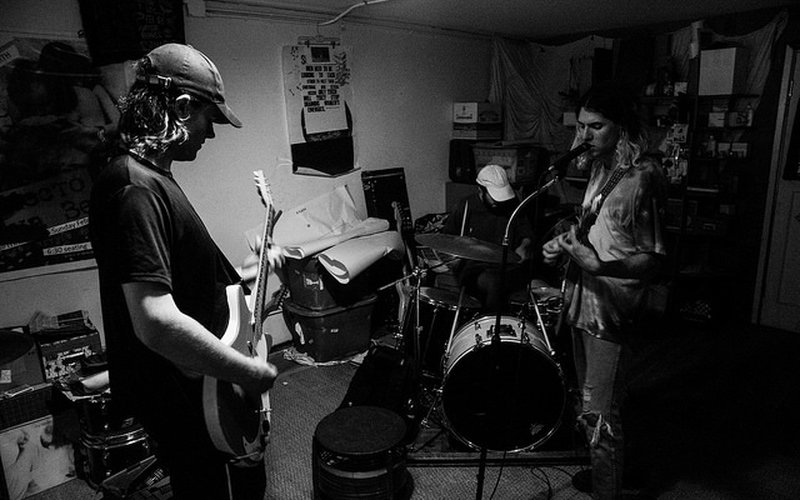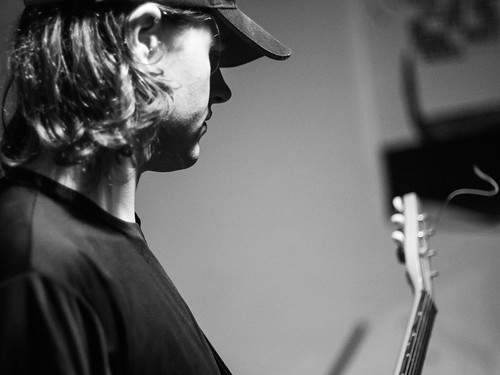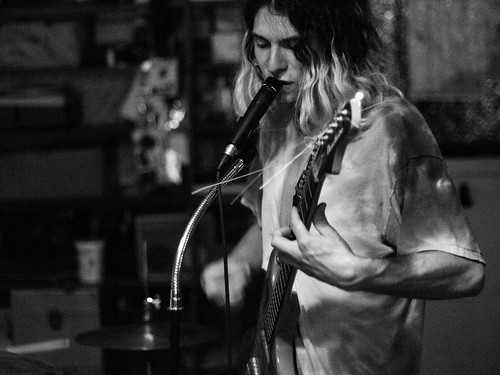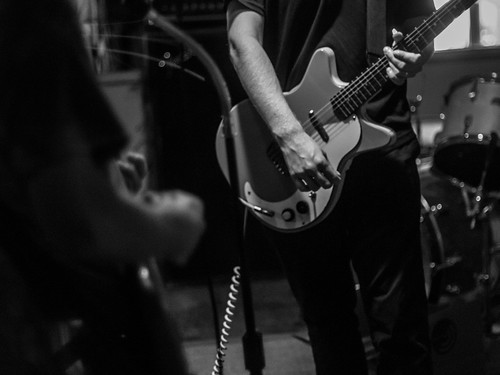
Introduction 1
Wildfire haze hangs over Olympia on the first day of August. Naomi Punk is stowed away in their lofted practice space in the back of Dumpster Values, a thrift shop in the center of town. It's 89 degrees but the air in the room feels even more ghastly and claustrophobic.
"Scorpion glue all over my body," Travis Coster belts into the microphone. The amps are fizzling static, blown out from a previous practice. The band is working out some kinks on their song "Chapter II" from their latest album, Yellow, out now on Captured Tracks. Guitarist Neil Gregerson forcefully bends the notes on his pale pink Danelectro, distorting and wobbling out of the speaker, while drummer Nic Luempert methodically pummels his kit. They're getting ready for their upcoming set at Olympia Hardcore Fest, their first show after the album drops.
Introduction 2
"I've definitely been thinking about the multiverse for the last three years making the album," Naomi Punk guitarist and vocalist Travis Coster says, sitting next to his two bandmates outside of a water conservation center in the band's hometown of Olympia, Washington. Moments ago we were just talking about the band reacting to being in the studio after the 2016 presidential election and soon we'll be discussing the openness of nature as inspiration. The band isn't jumping topics wildly for no reason – there's just a lot to cover with their new double album.

Here is the part where typically I'd give you some solid background information on the band — the "nut graf," for all you journalism purists out there. Typically this would include a bit about the rich DIY/indie rock history that comes from their hometown. I'd definitely mention something tantalizing about the band making a huge artistic leap forward with this record. Maybe I'd mention grunge as a reference point to understanding their "avant garde art rock" and throw in something about how the band originally started as a solo project for guitar and vocalist Travis Coster before he recruited--
"It's not really like that," Coster says, looking down and dragging a cigarette after I start reciting the band's bio back to them. Coster and co. aren't super keen on establishing narratives around their music.
"So many people interpret music through narratives and context, and then they impose that onto you for a long time," Coster says. "We already knew that writers and stuff make it weird. We didn't fill in the gaps for people because it wasn't really interesting to us to be a part of the expression of the music."
And, you know, Coster's right. As the band walked me through their winding origins, from Coster's infatuation with the other two's previous band Masters & Johnson to creating "Naomi Punk" as a live act on the road once one of Coster's singles got buzz on a blog and through their 2012 debut LP The Feeling, it became clear that those details don't really speak to what the band really is and what Yellow, a 25-track behemoth album, is really about. Or maybe, to make it easier, what it isn't about.
Look, Yellow's a pretty wild record. The album opens with two separate introduction tracks, each fading in so you intentionality don't know what to set the volume to. There's a narrator that comes in pronouncedly at sporadic points in the record, garbling in a ghoulish monotone. Some of the songs were written with the band playing in the mindset of a fictional group they created called The Scorpions. Tracks sound wildly different, almost like they belong to different bands or albums altogether. There's a lot going on. It's also a beautiful, difficult, and enrapturing listen for those who wish to enter Naomi Punk's world for an hour and 15 minutes. So if talking about typical narrative questions doesn't work, we turn the conversation toward what Naomi Punk looks like without narrative. What is Naomi Punk about?
"We might have to talk about this for a while," Gregerson says after a long collective pause from the band.

While not the sole inspiration behind the record, the idea of the rock or punk band narrative, least in part, spurred some of the thoughts that led to Yellow's birth. Somewhere along the way, the band says the found themselves "thrown into the machine" – the "machine" being the music industry cycle for working bands. Having spent so much time existing within DIY scenes and spaces, they've been able to maintain their skepticism of the industry model as a whole.
"Everyone wants you to make ten songs for the LP and then five songs for the EP and it's like this capitalist formula," Coster says. "And then you record them all at the same time and then you release the EP while you're on tour for the LP and then it gives you a bump and then you can do more touring and that whole scheme."
This doesn't only extend to putting out and releasing records. It also applies to the continual grind of playing shows on the road – or at least not playing the types of shows that Naomi Punk would typically see themselves playing. A tour with labelmate Mac Demarco found the band less than enthused with the idea of performing at traditional clubs and venues night after night.
"You play to the same people. You play at the same time. This green room looks the same. All the beers are the same. The audience is all for the same, weird stupid reasons mainly. Not to diss anybody. It's such a capitalist trap," Coster says. Gregerson chimes in to add that getting to play shows with better sound was a benefit, letting them better hear their own instruments and how different they compared to other acts. In the van rides between gigs, the band would spend a lot of time dissecting and ribbing the punk machoism they'd see at shows. This led to them heavily discussing something they'd actually like to see in a record – alongside jokes that they should make a "yellow" record and to start listening to other albums that heavily featured the color.

"We were trying to come up with an idea that was driving us but we didn't really know what it was, so we were working out our different ways of relating to each to create this idea of yellow," Luempert says. "We were trying to center our productive energy on one thing but trying to keep it as open as possible."
The concept of "yellow" is massively broad and the band approaches it with complete knowledge of that. It's what makes it such a perfect theme for the record. Coster explains how colors themselves are a metaphor for variability, saying that he could show someone a variety of different swatches and have all of the shades fall under the category of yellow. He says it's "thinking about color as this infinite space because we're taught that colors are certain things but there's so much movement in all those ideas." The vastness of the concept manifests itself aptly in the record. At one point they say it feels in ways like the true Naomi Punk debut and yet also look at Yellow as a project in and of itself. The trio all enthusiastically explain this idea of creating their own world within the album. It's a world that Coster says he likes commenting from afar, from his "humble vantage point of someone singing in a song" and acknowledging the magnetosphere.
"We wanted the seams to show," Gregerson says. "And that's what the double album is really all about. We decided to bite off a lot of space. Audio space. A single album, you have, what, 25 minutes on each side max. You don't really have a lot of time to spend getting into some deeper layers of shit. You want it to be this cohesive record, bring someone into a world but you only have so much time."
"Cookie" isn't the first song on the record, it's technically fourth after the two intros and a manic instrumental track called "Chernobyl Carrot," but it's the first track that we begin to hear Coster's perspective on this world. It's much more metaphysical than a passing observation of "the state of things." He monotone-belts into the mic, "I found the key to my healing and the move of my hips/I read all the think pieces/they didn't do shit." Quickly the drama heightens over the rhythmic surge and halt of the ragged guitar lines. "Extraterrestrial angelfire/the earth answers in angelfire/no hope for peace/flag of fire," he sings. Coster says "angelfire" isn't a reference to the free website service that was popularized in the '90s (though it was influential to him when he was finding music in his youth), but it's the feeling of the words that resonate with him. Sitting on the concrete bench outside the water conservation center, he repeats the line, "the earth answers in angelfire" and responds himself with, "hell yeah, yeah it does." He continues:
"Starting off with this idea that 'I found the key to my healing' is such a cheesy and untrue statement. But it's such an interesting notion to riff on and to bring people into that space because people feel that way all the fucking time and you know it and you feel it and you're so moving into some new space of a higher understanding beyond reading about Sean Spicer in the New York Times or something. Being above these weird melodramas of people fighting about shit on Instagram in political posts and shit. Or just being so immersed in these pleb worlds, basically. Then coming into this new space. Reading shit. Think pieces. And how people try to explain shit to you like TedTalk radio hour and shit. How that's so caging in the world that I'm existing in and it's so obvious to me and I just feel it so hard."He then sums it up even more neatly.
"Meanwhile while you're talking about that or at a bar listening to rock music, drinking a beer and talking about the weather, I'm like noticing angelfire and the earth responding to these forces," Coster says.
This is all before we dig into another big idea behind the record – the music as an experience. It's part of what drives the band away from the idea of narratives. Yellow isn't designed to be a conventional album that collects some of their songs they've been working on into one simple, digestible package. Nor is it meant to be an antagonistic scoff at the way things are. In a way, it's a means of capturing the same feelings the band would get in a pit at a show seeing the best band in the world and being enveloped in that moment.
"Experiencing things through a rock canon or something like that isn't the way we actually feel like we interact with music and we're trying to figure out a way of expressing the way that we actually are experiencing music and it's not through these canons," Luempert says. "It's not us trying to be outside, it's us trying to figure out how these elements that do make up these ideas of canons and stuff, how we actually experience them."

The variable tracks on the album are a testament to this idea, feeling impulsive and experiential in themselves. Listening to the record on headphones, the listener will hear layers upon layers of guitars mixed with found audio and a fluttering sound that mirrors the lyrical theme of "I found my angel wings" carried throughout the record. The band allows themselves to feel things the way they sense they ought to be.
The song "My Shadow" stands out enough because of its lush synthesizer droning and drum machine thuds. It's an instrumental track as it appears on Yellow, but it wasn't originally intended that way. Coster had lyrics written and even recorded, but he says once he listened to it instrumentally it brought him to tears and he knew it had to be that way. He muted his vocals but the lyrics are still present on the lyric sheet and in the music video – a personal mantra in which he says, "I never thought I'd know this way of seeing. I never thought I'd know this way of being." We might not be able to hear those words, but they can be felt in the music.
So, what is Naomi Punk about? What is Yellow? By the end of the conversation, we have seemingly infinite different answers. But it's getting dark. The sun's gone down but the heat and forest fire smoke still linger quietly in the air. We start packing up and a security guard comes by to wave us off. We walk back to their practice space and then split ways. I get into my car and play Yellow again for the drive back to Seattle – the album is coincidently almost exactly the length of the trip. I listen closely rolling down I-5, trying to experience the album in new ways even after listening to it so many times before even coming to Olympia. It's even more hypnotic than ever.
Yellow is a disorienting listen at first. It's a record that doesn't reveal itself quickly but warrants the time. Each song feels like a world in itself, a multiverse. It may appear ambitious, but it's also a simple effort to express the magic behind the music. It's music distilled into its purest intentions of the creators. A feeling like that doesn't need to be bottled into a narrative. It just needs to be experienced.
Yellow is out now via Captured Tracks. Naomi Punk plays their LP release show at Fred Wildlife Refuge on August 9 at 8 pm with Dreamdecay, Ghostbitch, and DJ Having Sex.

Grammy-nominated singer Mary Lambert has been doing things for herself lately. And, she says, it feels exhilarating. But between performances and business moves – like signing her own distribution deal and releasing her latest EP, Bold, in May – she’s been playing a lot of The Sims computer game, c…
Every week, KEXP features a new local artist with an interview and suggested tracks for where to start. This week, we’re featuring Seattle's Telekinesis, who play Concerts at the Mural this Friday, August 11. with SISTERS and Haley Heynderickx.
For fans of '90s shoegaze, the past few years have been a rush of reunions: Slowdive. Ride. Lush. Swirlies. Okay, hear me out. Unlike their UK contemporaries, the at-the-time Boston-based band followed a more lo-fi path, combining a DIY, punk aesthetic with their swoony, well, "swirly" guitars. In …
Every week, KEXP features a new local artist with an interview and suggested tracks for where to start. This week, we’re featuring Portland-via-Beaverton duo The Helio Sequence, who play Concerts at the Mural tonight with Summer Cannibals and COSMOS.